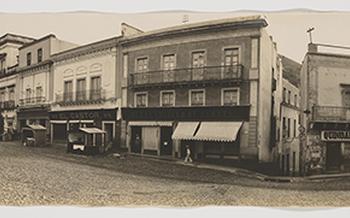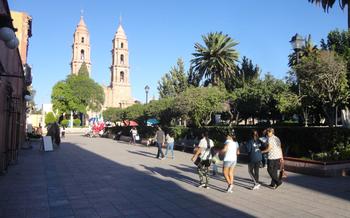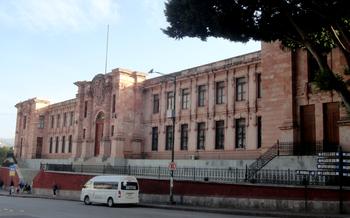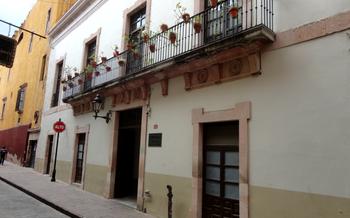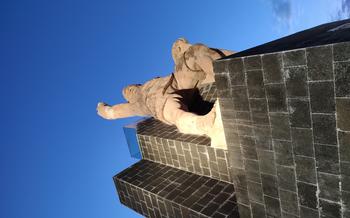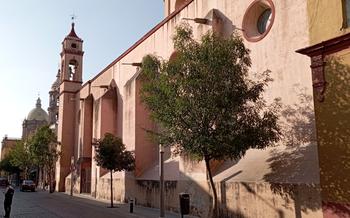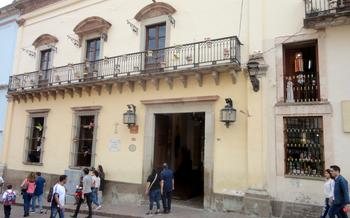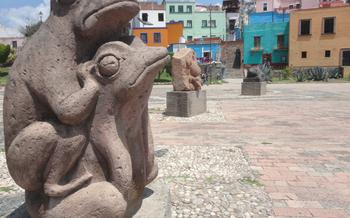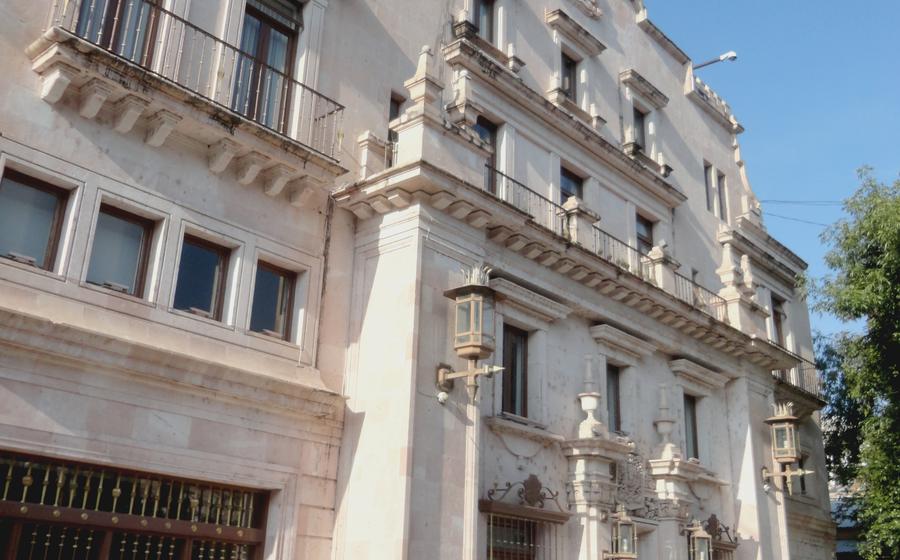
La Esperanza Granada Mine (Mina La Esperanza Granada)
- History of La Esperanza Granada Mine (Mina La Esperanza Granada)
- Location and Accessibility
- The Hacienda
- The Mining Tunnels
- The Mining Equipment
- The Minerals
- The Museo de las Momias (Mummy Museum)
- The Alhóndiga de Granaditas Historical Museum
- The Monumento al Pípila (Monument to the Pípilaípila, a tribute to the bravery and sacrifice of Juan José Martínez, a local miner who played a pivotal role in the Mexican War of Independence. The monument, inaugurated in 1891, is a symbol of the city's patriotic spirit and a poignant reminder of the struggle for freedom.
- Insider Tip
History of La Esperanza Granada Mine (Mina La Esperanza Granada)
La Esperanza Granada Mine, nestled in the heart of Guanajuato, Mexico, holds a rich history that dates back to the 17th century. During this period, the mine was a pivotal site for silver mining, contributing significantly to the city's prosperity and reputation as a mining hub. In its early years of operation, the mine employed rudimentary mining techniques, primarily relying on manual labor and simple tools to extract the precious metal from the earth. As the 18th century dawned, more advanced techniques, such as the amalgamation process, were introduced to improve efficiency and increase silver output.
Despite its early success, the mine eventually faced challenges and was abandoned in the late 18th century due to flooding and declining silver reserves. Over time, the mine fell into oblivion, its existence fading from memory until its rediscovery in the 20th century. This remarkable event sparked renewed interest in the mine's history, leading to its preservation and eventual transformation into a popular tourist attraction that showcases the legacy of Guanajuato's mining heritage.
Location and Accessibility
La Esperanza Granada Mine (Mina La Esperanza Granada) is strategically nestled in the heart of Guanajuato city, a captivating UNESCO World Heritage Site. To reach this subterranean marvel, one can embark on a scenic 15-minute walk from the city's central Jardín de la Unión. Alternatively, for those seeking a more leisurely approach, local buses conveniently stop nearby, providing easy access to the mine.
Guided tours are meticulously designed to unveil the mine's captivating history and intricate workings. These tours, conducted in both Spanish and English, are reasonably priced, ensuring that every visitor has the opportunity to delve into the depths of this captivating subterranean realm. Embarking on a guided tour is highly recommended, as the knowledgeable guides provide invaluable insights, enriching the overall experience.
The Hacienda
Deep within the rugged hills of Guanajuato, cradled by the towering Sierra Madre Occidental, lies the Hacienda de la Esperanza, a testament to the rich mining heritage of this vibrant city. This architectural gem, with its grand facade and ornate interiors, once served as the beating heart of the La Esperanza Granada Mine.
Constructed in the 18th century as the nerve center of the mining operations, the hacienda was meticulously designed to support the miners and facilitate the extraction of precious metals. Its sturdy walls embraced the administrative offices, storerooms, workshops, and living quarters, forming a bustling hub of activity.
The hacienda's design reflected both practicality and elegance, with a spacious courtyard serving as the central gathering space. The sturdy arches and stone pillars, reminiscent of a bygone era, spoke of the enduring strength and resilience of the mining industry.
Today, this architectural masterpiece has been lovingly restored and repurposed as a cultural center, inviting visitors to step back in time and experience the rich history and legacy of Guanajuato's mining heritage. Its transformation into a vibrant cultural space has breathed new life into the old hacienda, while preserving its historical significance.
The Mining Tunnels
The mine's underground network, a labyrinth of tunnels and shafts, is a testament to the ingenuity and perseverance of the miners who worked here. These tunnels, carved out of solid rock with simple tools, extend for several kilometers, reaching depths of over 100 meters. Exploring these tunnels is a unique and awe-inspiring experience, as they remain much as they were centuries ago.
Before venturing into the tunnels, it is essential to take safety precautions. Wear sturdy shoes, comfortable clothing, and a hard hat, as the tunnels can be slippery and uneven. Bring a flashlight or headlamp to illuminate your path. It is also wise to stay with a group or guide, as the tunnels can be disorienting.
As you explore the tunnels, take note of the various features that showcase the miners' skill and dedication. Look for evidence of the mining methods used, such as the chisel marks on the walls and the remains of wooden supports. Admire the intricate ventilation systems designed to circulate air and remove harmful gases. Keep an eye out for waterwheels and other machinery that facilitated the mining process.
The Mining Equipment
The La Esperanza Granada Mine has preserved various tools and machinery that played a crucial role in the mining process. These include picks, shovels, and hammers, which were essential for extracting the ore from the rock. Carts and pulleys were used to transport the ore from the mine shafts to the surface.
The mine also utilized a variety of pumps to remove water from the tunnels, as flooding was a constant challenge for miners. These pumps were powered by animals or human labor, and their operation required considerable effort and coordination.
Another significant piece of equipment was the amalgamation mill, which was used to separate the silver from the other minerals in the ore. The amalgamation process involved grinding the ore into a fine powder and mixing it with mercury. The mercury would bind to the silver, forming an amalgam, which was then heated to vaporize the mercury and leave behind the pure silver.
The preservation and display of this mining equipment offer visitors a glimpse into the technological advancements and challenges faced by miners during the colonial period. These tools and machinery stand as a testament to the ingenuity and resourcefulness of the miners who worked in the La Esperanza Granada Mine.
The Minerals
The La Esperanza Granada Mine yielded various valuable minerals that played a significant role in Guanajuato's mining history. Silver was the primary mineral extracted from the mine, and its abundance made Guanajuato one of the leading silver producers in the world during the 17th and 18th centuries. The mine also produced significant quantities of gold, which further contributed to the city's wealth.
To extract these minerals, miners employed various techniques. They used pickaxes and shovels to break the rocks and wheelbarrows to transport them to the surface. Once the rocks were brought up, they were crushed and processed using a method called amalgamation. This process involved mixing the crushed ore with mercury to form an amalgam, which was then heated to separate the silver and gold from the mercury.
The minerals extracted from the La Esperanza Granada Mine had a profound impact on the economy and society of Guanajuato. The wealth generated from mining fueled the city's growth and development, leading to the construction of impressive colonial-era buildings and the establishment of a vibrant cultural scene. The mining industry also attracted a diverse population to Guanajuato, including Spanish colonists, indigenous laborers, and African slaves, who all contributed to the city's rich cultural heritage.
The Museo de las Momias (Mummy Museum)
Within the perimeter of the Ex-Hacienda de la Esperanza, travelers can stumble upon a peculiar sight: the Museo de las Momias (Mummy Museum). Established in 1994, this museum houses an eerie yet captivating collection of over 100 naturally mummified bodies, inviting visitors to delve into the fascinating world of death and preservation.
The mummies on display were unearthed from the Panteón de Santa Paula, the city's former cemetery, during the 19th century. Due to the unique combination of Guanajuato's dry climate, the minerals in the soil, and the elevated altitude, the bodies underwent a natural mummification process.
The museum's exhibits provide a glimpse into the lives of these individuals, showcasing their clothing, personal belongings, and even their medical conditions. Through these mummified remains, visitors gain a profound understanding of Guanajuato's history, culture, and the complex relationship between life and death.
The Alhóndiga de Granaditas Historical Museum
The Al impressive Neoclassical building occupies a prominent position in the city's historical center.
In 1810, the Alhóndiga de Granaditas became a pivotal site in the struggle for Mexican independence. On September 28, 1810, the insurgent leader Miguel Hidalgo y Costilla, known as "the Father of Mexican Independence," led an attack on the building, which was then used as a royalist stronghold. The battle, known as the Battle of Alhóndiga de Granaditas, resulted in a victory for the insurgents, marking a significant moment in the fight for Mexican independence.
In the aftermath of the battle, the Alhóndiga de Granaditas was converted into a prison and later served as a military barracks. In 1958, the building underwent extensive renovations and was transformed into a museum dedicated to preserving and showcasing Guanajuato's historical artifacts and documents.
Today, the Alhóndiga de Granaditas Historical Museum houses a vast collection of exhibits that narrate the history of Guanajuato from the pre-Hispanic era to the present day. Visitors can explore galleries showcasing indigenous artifacts, colonial-era paintings, religious sculptures, and relics from the Mexican War of Independence.
One of the highlights of the museum is the "Sala de la Independencia," which features a captivating diorama depicting the Battle of Alhóndiga de Granaditas. The museum also houses a library and an archive that contain valuable historical documents and manuscripts.
With its impressive architecture, rich historical exhibits, and captivating stories, the Alhóndiga de Granaditas Historical Museum offers a profound insight into Guanajuato's past and its pivotal role in Mexico's struggle for independence. It stands as a symbol of resilience, courage, and the enduring spirit of the Mexican people.
**The Monumento al Pípila (Monument to the Pípilaípila, a tribute to the bravery and sacrifice of Juan José Martínez, a local miner who played a pivotal role in the Mexican War of Independence. The monument, inaugurated in 1891, is a symbol of the city's patriotic spirit and a poignant reminder of the struggle for freedom.
The monument depicts Martínez, also known as El Pípila, carrying a large millstone on his back, an act that earned him a place in history. During the Siege of Guanajuato in 1810, Martínez volunteered to set fire to the door of the Alhóndiga de Granaditas, a fortified granary where the Spanish royalists had taken refuge. Under heavy enemy fire, he fearlessly approached the building, using the millstone as a shield to protect himself from the bullets. His heroic act allowed the insurgent forces to gain entry and ultimately capture the granary, marking a turning point in the battle.
The Monumento al Pípila stands tall in the heart of Guanajuato, a testament to the courage and resilience of the Mexican people. It serves as a reminder of the sacrifices made during the fight for independence and continues to inspire generations with its message of patriotism and bravery.
Insider Tip
To fully immerse yourself in the mining experience, plan your visit to the La Esperanza Granada Mine during the annual Festival Internacional Cervantino, typically held in October. This world-renowned arts festival transforms Guanajuato into a vibrant cultural hub, offering a unique blend of theater, music, dance, and visual arts.
While in Guanajuato, don't miss the opportunity to savor the local cuisine. Head to the Mercado Hidalgo, a bustling market filled with food stalls and restaurants serving traditional Mexican dishes. Try the enchiladas mineras, a local specialty featuring corn tortillas filled with cheese and topped with a spicy red sauce. For a sweet treat, indulge in a cajeta, a caramel sauce made from goat's milk.
Beyond the mine, Guanajuato offers a treasure trove of hidden gems waiting to be discovered. Explore the narrow cobblestone streets, lined with colorful colonial-era buildings and charming boutiques. Visit the Museo Iconográfico del Quijote, dedicated to the iconic novel "Don Quixote" by Miguel de Cervantes. For a breathtaking view of the city, climb up to the Mirador del Pípila, a viewpoint overlooking the cityscape from a hilltop.
